Welcome to the Utopia Guide Massage, a journey into the world of therapeutic touch and holistic well-being. This guide offers a comprehensive approach to understanding and mastering massage techniques, designed to enhance relaxation, ease tension, and promote overall health. Whether you’re a professional therapist or a curious beginner, this guide will serve as your roadmap to creating meaningful and transformative massage experiences. Let’s embark on this path to wellness together!
1.1 What is Utopia Guide Massage?
Utopia Guide Massage is a holistic approach to therapeutic touch, blending traditional massage techniques with modern practices to promote deep relaxation and overall well-being. Designed for professionals and beginners alike, this comprehensive guide offers a clear framework for mastering effective massage methods. It helps enhance physical comfort, ease muscle tension, and improve circulation, nurturing the body, mind, and spirit.
1.2 The Benefits of Utopia Guide Massage
The Utopia Guide Massage offers numerous benefits, including deep relaxation, stress relief, and improved physical well-being. It helps ease muscle tension, enhance circulation, and promote emotional balance. Regular practice can lead to better sleep quality, reduced pain, and increased mental clarity. This approach fosters a deeper connection between body and mind, creating a pathway to lasting wellness and harmony.
1.3 Setting Intentions for the Perfect Massage Experience
Setting intentions is the cornerstone of a transformative massage experience. Define your goals, whether it’s relaxation, pain relief, or emotional release. Create a calm mindset, communicate openly with your partner or therapist, and allow yourself to fully surrender to the process. By setting clear intentions, you invite a deeper connection and maximize the therapeutic benefits of your massage session.
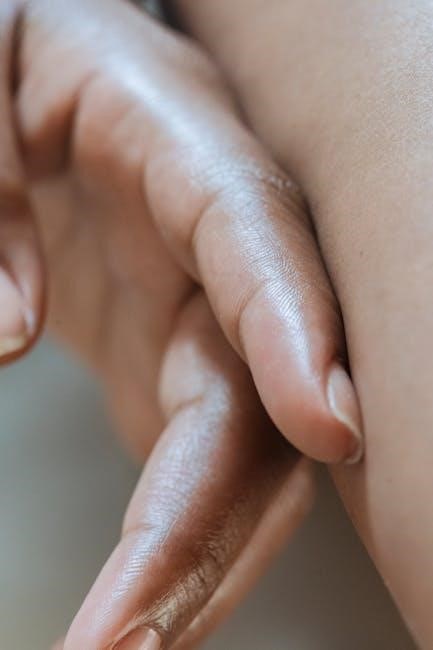
Understanding the Basics of Massage
Understanding the basics of massage is essential for mastering its techniques and benefits. This section explores fundamental principles, key concepts, and the core elements of massage therapy.
2.1 Types of Massage Techniques
Massage techniques vary widely, each offering unique benefits. From gentle strokes of Swedish massage to deep pressure in sports therapy, and the targeted approaches of trigger point therapy, each method caters to specific needs. Understanding these techniques allows practitioners to tailor sessions effectively, ensuring a personalized experience for every individual. This diversity in techniques is a cornerstone of the Utopia Guide Massage philosophy.
2.2 The Importance of Touch and Pressure
Touch and pressure are fundamental elements in massage, influencing both physical and emotional responses. The right pressure can ease muscle tension, while gentle touch fosters trust and relaxation. Understanding how to adapt pressure to individual needs ensures a safe and effective massage experience. This balance is crucial for achieving therapeutic benefits and creating a meaningful connection during a session.
2.3 Key Principles of Massage Therapy
The foundation of massage therapy lies in its core principles: client-centered care, proper body mechanics, and respect for individual needs. Techniques should be applied with intention, ensuring comfort and safety. Communication, consent, and adaptability are essential for a positive experience. By honoring these principles, massage becomes a powerful tool for promoting physical and emotional well-being, fostering trust, and creating a safe, therapeutic environment.
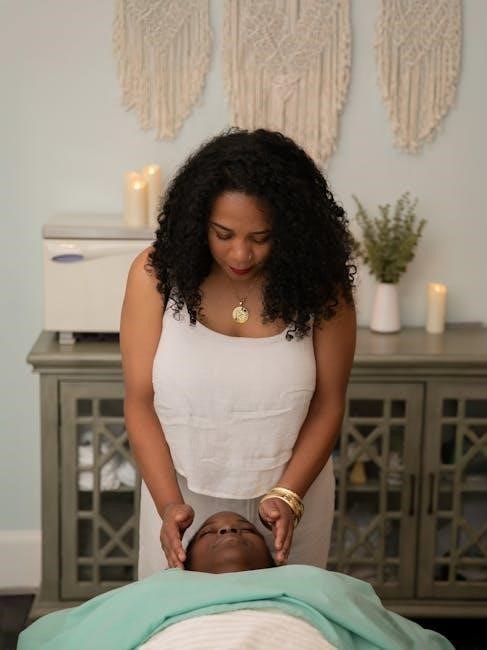
Preparing for the Utopia Guide Massage
Preparing for the Utopia Guide Massage involves creating a harmonious blend of physical comfort and mental readiness. Set up your space, ensure comfort, and gather essential tools. A clear mind and focused intentions will enhance your experience, allowing you to fully embrace the therapeutic journey ahead.
3.1 Creating a Relaxing Environment
Creating a relaxing environment is key to enhancing your massage experience. Begin by dimming the lights or using candles to create a soothing ambiance. Ensure the room temperature is comfortable and consider playing calming music or white noise to minimize distractions. Keep the space clutter-free and organized to promote a sense of calm. A clean, fresh scent, such as essential oils, can further enhance relaxation. Finally, ensure privacy and comfort, allowing you and your partner to fully immerse in the experience.
3.2 Essential Oils and Their Role in Massage
Essential oils are a powerful addition to massage, enhancing relaxation and emotional well-being. Lavender oil promotes calmness, while peppermint invigorates the senses. Frankincense and eucalyptus are known for their therapeutic properties, reducing inflammation and easing muscle tension. Always dilute essential oils with a carrier oil, such as coconut or jojoba, to ensure safe and effective use during your massage session. They elevate the experience, creating a deeper connection to the healing process.
3.3 Pre-Massage Rituals for Maximum Relaxation
Pre-massage rituals set the stage for a profound experience. Begin by dimming lights, playing soothing music, or lighting candles to create a calming ambiance. Incorporate deep breathing exercises or meditation to quiet the mind. A warm bath or shower can soften muscles, while a cup of herbal tea nurtures relaxation. These rituals help transition into a receptive state, enhancing the massage’s therapeutic benefits and fostering a deeper connection to the process.
The Art of Massage Techniques
This section delves into the core techniques of massage, from foundational strokes to advanced methods, emphasizing their role in promoting relaxation, relieving tension, and enhancing overall well-being.
4.1 Effleurage: The Foundation of Massage
Effleurage is the cornerstone of massage, characterized by long, flowing strokes that glide over the skin. It promotes relaxation, improves circulation, and prepares the muscles for deeper work. Often performed with the palms, this technique creates a sense of rhythm and connection, easing tension and setting the stage for a therapeutic experience.
4.2 Petrissage: Kneading for Deep Tissue Relief
Petrissage involves kneading techniques that target deeper tissues, providing relief from muscle tension and knots. Using the hands, knuckles, or fingers, this method lifts, squeezes, and releases soft tissue. It enhances circulation, breaks down adhesions, and promotes relaxation. Commonly applied to areas like the neck, shoulders, and thighs, petrissage is invigorating yet therapeutic when performed with controlled pressure and rhythm.
4.3 Tapotement: Stimulating the Nervous System
Tapotement involves rhythmic tapping, cupping, or hacking strokes to stimulate the nervous system. It increases alertness, enhances muscle tone, and prepares the body for deeper massage work. Commonly applied to areas like the shoulders, thighs, and arms, tapotement improves circulation and energizes the tissues. When performed gently, it can be invigorating, though it may not be suitable for everyone, especially those with sensitive conditions.

Focusing on Specific Areas
Focusing on specific areas allows for targeted relief from tension and stress. Techniques tailored to the neck, shoulders, back, arms, and legs enhance relaxation, improve flexibility, and promote overall well-being.
5.1 Massaging the Neck and Shoulders
Massaging the neck and shoulders targets common areas of tension caused by stress and poor posture. Use gentle, flowing strokes to ease muscle tightness. Incorporate kneading and gentle stretches to release knots. Focus on the base of the skull and shoulder blades for deep relaxation. Techniques like effleurage and trigger point therapy can relieve pain and improve circulation, offering quick relief from tension headaches and stiffness. Regular massage here enhances posture and mobility, promoting long-term well-being.
5.2 Techniques for the Back and Spine
Massaging the back and spine involves long, flowing strokes to relax muscles and improve spinal alignment. Use deep pressure along the vertebrae to release tension. Techniques like effleurage and petrissage can ease muscle knots, while gentle stretches enhance flexibility. Pay attention to the lower back, a common area for strain. Regular massage here can reduce pain, improve posture, and promote a sense of balance and overall well-being.
5.3 Soothing the Limbs: Arms and Legs
Massage techniques for arms and legs focus on long, gliding strokes to relieve muscle tension and improve circulation. Use gentle kneading for the thighs and calves, while lighter pressure suits the arms. Incorporate gentle twisting motions for joint flexibility. Pay attention to pressure points on the feet and hands for localized relief. Regular limb massage enhances mobility, reduces stiffness, and promotes a sense of lightness and renewed energy throughout the body.
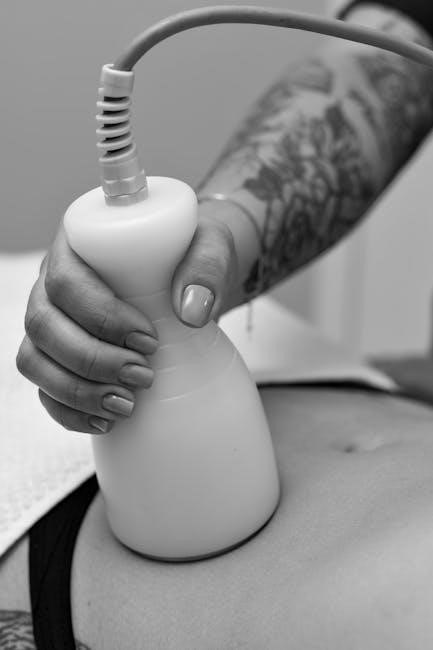
Advanced Massage Techniques
Discover specialized methods to enhance your massage practice, including trigger point therapy and myofascial release, designed to address chronic tension and promote deep relaxation for optimal well-being.
6.1 Trigger Point Therapy
Trigger point therapy targets knotted muscles to relieve pain and tension. By applying focused pressure, it releases tight muscle fibers, improving blood flow and reducing discomfort. This technique is particularly effective for addressing chronic pain, stiffness, and limited mobility. Professionals often use it to treat conditions like sciatica and fibromyalgia. Regular sessions can enhance flexibility and overall well-being, making it a cornerstone of advanced massage practices.
6.2 Myofascial Release
Myofascial release is a gentle, sustained technique targeting the fascia, the connective tissue surrounding muscles. By releasing fascial tension, it alleviates pain, enhances flexibility, and restores range of motion. This method is particularly effective for chronic pain, scar tissue, and poor posture. Practitioners use light, prolonged pressure to encourage the fascia to relax, promoting a deeper sense of relaxation and improving overall mobility and well-being.
6.3 Incorporating Energy Work
Incorporating energy work into your massage practice can deepen relaxation and enhance healing. Techniques like Reiki, chakra alignment, and aura cleansing balance the body’s energy flow. By channeling and clearing energy, you can address emotional and spiritual blockages, creating a holistic experience. This practice fosters a deeper connection between mind, body, and spirit, amplifying the therapeutic benefits of massage and promoting overall well-being.

The Science Behind Massage
Understanding the science behind massage reveals its impact on the nervous system, endorphin release, and circulation improvement, enhancing therapeutic effects and promoting overall well-being.
7.1 How Massage Affects the Nervous System
Massage stimulates nerve endings, calming the nervous system and promoting relaxation. It reduces stress hormones like cortisol, while increasing oxytocin, serotonin, and dopamine, enhancing mood and pain tolerance. The parasympathetic response is activated, slowing heart rate and deepening breathing, fostering a state of tranquility. Regular massage can improve nervous system regulation, benefiting both physical and mental health by reducing anxiety and stress. This therapeutic effect creates a balanced, serene state of being.
7.2 The Role of Endorphins in Pain Relief
Massage triggers the release of endorphins, the body’s natural painkillers, reducing discomfort and promoting relaxation. These chemicals bind to pain receptors, easing muscle tension and inflammation. By stimulating nerve endings, massage increases endorphin production, which also improves mood and emotional well-being. Regular massage can lead to sustained endorphin levels, enhancing the body’s ability to manage chronic pain and stress, fostering overall wellness and comfort naturally.
7.3 Improving Circulation and Lymphatic Flow
Massage enhances blood circulation by increasing the efficiency of blood flow, delivering oxygen and nutrients to tissues. It also stimulates the lymphatic system, aiding in the removal of toxins and excess fluids. Improved circulation reduces muscle tension, enhances recovery, and promotes healthier skin. Regular massage can also alleviate swelling and support the body’s natural detoxification processes, contributing to overall well-being and vitality.
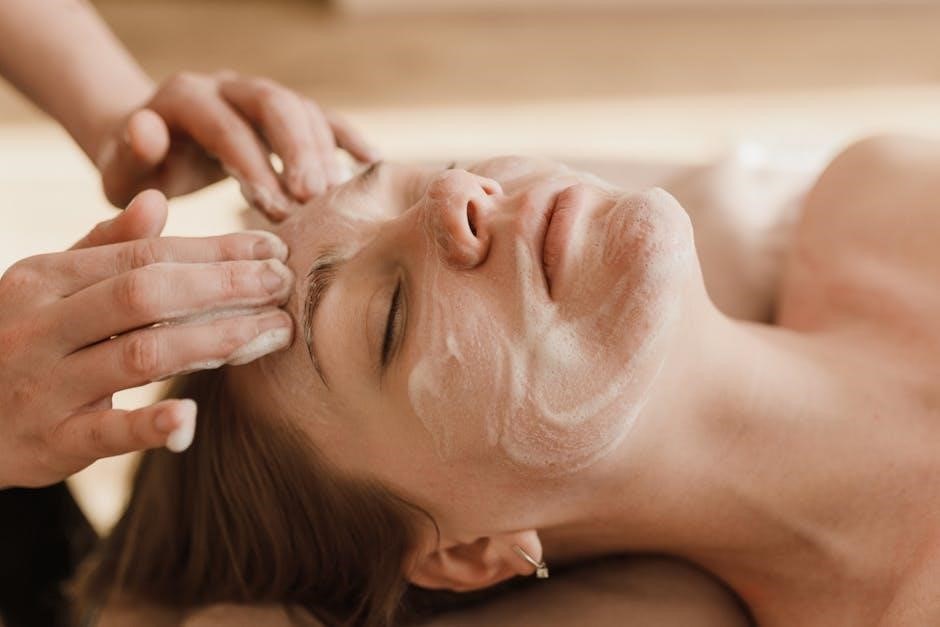
Safety and Contraindications
Understanding contraindications and safety measures is crucial for a safe massage experience. Certain conditions may make massage inadvisable, and professional consultation is essential to avoid risks. Open communication ensures a secure and beneficial session.
8.1 When to Avoid Massage
Massage should be avoided in certain situations to prevent potential harm. Acute injuries, severe inflammation, or infections may worsen with massage. Conditions like deep vein thrombosis, recent fractures, or active cancer require caution. Massage is also contraindicated during severe illnesses or fevers. Always consult a healthcare professional before receiving a massage if you have underlying medical conditions or concerns.
8.2 Common Mistakes to Avoid
Common mistakes during massage include applying too much pressure, neglecting proper body mechanics, and failing to communicate with the client. Overlooking areas of tension or moving too quickly can reduce effectiveness. Additionally, not using enough lubrication or ignoring the client’s feedback can lead to discomfort. Being mindful of these pitfalls ensures a safer and more enjoyable experience for both parties involved.
8.3 Communicating with Your Client or Partner
Clear communication is essential for a successful massage experience. Always ask for feedback on pressure and technique, ensuring comfort and satisfaction. Encourage open dialogue about areas of tension or discomfort. Active listening and empathy build trust, while regular check-ins during the session ensure needs are met. This collaborative approach fosters a safe and effective environment, enhancing the overall benefits of the massage.
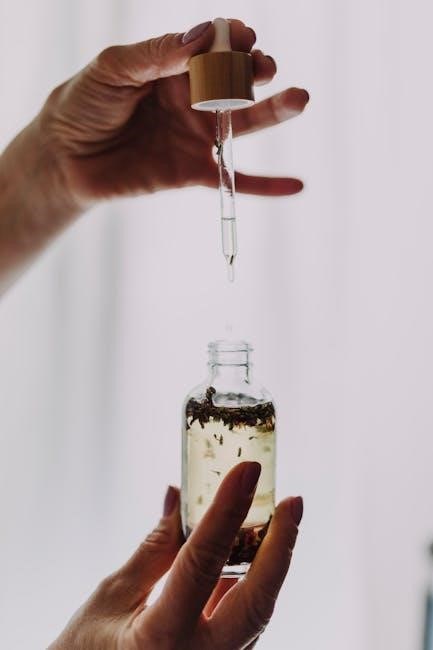
The Power of Aftercare
The Power of Aftercare emphasizes the importance of grounding, hydration, and emotional support post-massage; These practices enhance the benefits of the session, fostering a nurturing experience.
9.1 The Importance of Grounding After Massage
Grounding after massage is essential for transitioning smoothly from deep relaxation to alertness. Techniques like deep breathing, gentle stretches, or mindful meditation help stabilize the body and mind. This practice reduces dizziness, promotes balance, and enhances the overall therapeutic experience, ensuring a sense of calm and renewal lasts beyond the session.
9.2 Hydration and Nutrition Post-Massage
Hydration and nutrition play a vital role after massage, aiding the body in flushing out toxins released during therapy. Drinking water replenishes fluids, while nutrient-rich foods support muscle recovery. Avoiding caffeine and alcohol helps maintain relaxation, ensuring the body benefits fully from the massage experience. Proper post-care enhances overall well-being and prolongs the therapeutic effects of the session.
9.3 Emotional Support and Aftercare Practices
Emotional support and aftercare are essential for a holistic massage experience. Creating a safe, comforting environment helps individuals process emotions released during therapy. Active listening, reassurance, and gentle guidance foster trust and relaxation. Offering follow-up care, such as checking in post-session, enhances well-being and strengthens the therapeutic connection. These practices ensure a nurturing and supportive experience, amplifying the benefits of massage for body and mind.
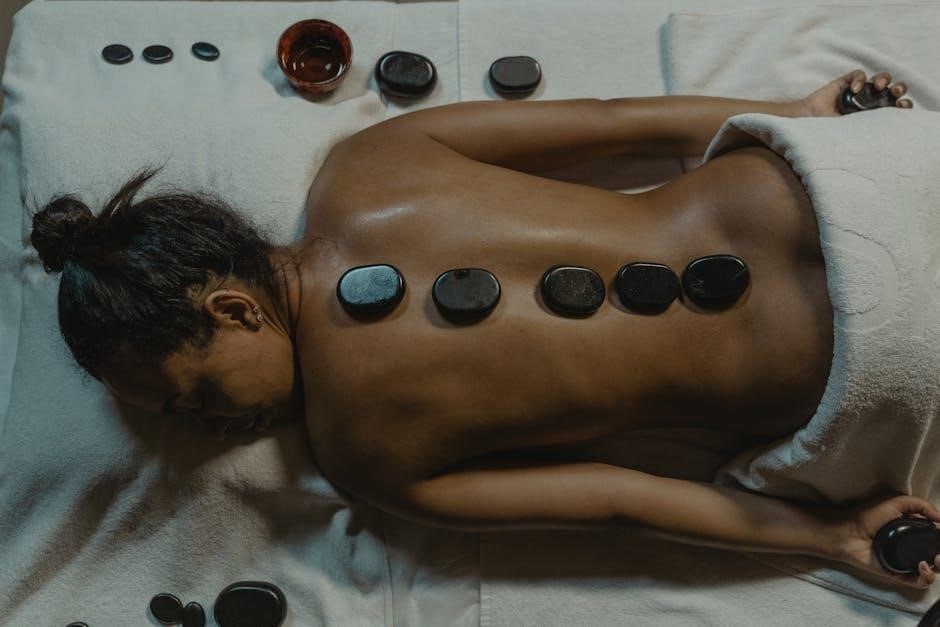
Tools and Products for Massage
Discover the essential tools and products for enhancing your massage experience. From massage balls and rollers to heat therapy tools, these enhance techniques, ease tension, and improve circulation.
10.1 Choosing the Right Massage Oil
Selecting the right massage oil is crucial for a smooth and rejuvenating experience. Consider oils like jojoba, sweet almond, or coconut for their moisturizing properties. Essential oils, such as lavender or eucalyptus, can enhance relaxation and provide therapeutic benefits. Always choose high-quality, pure oils that suit the skin type and preferences of the individual. Avoid oils with harsh chemicals to ensure a safe and enjoyable session.
10.2 The Use of Massage Tables and Cushions
Massage tables and cushions are essential for ensuring comfort and proper positioning during a session. A sturdy, adjustable table allows clients to lie comfortably while supporting their body weight. Cushions or bolsters can be used to support the neck, knees, or other areas, enhancing relaxation. Investing in a high-quality table with adequate padding ensures a safe and enjoyable experience for both the client and practitioner.
10.3 Incorporating Heat and Cold Therapy
Heat and cold therapy can enhance the massage experience by preparing muscles and reducing discomfort. Heat therapy, such as warm compresses or heating pads, relaxes muscles, improves circulation, and softens tissue for deeper work. Cold therapy, like ice packs or cooling gels, helps reduce inflammation and numbs pain, often applied after massage to prevent soreness. Balancing both can elevate the effectiveness of your sessions.
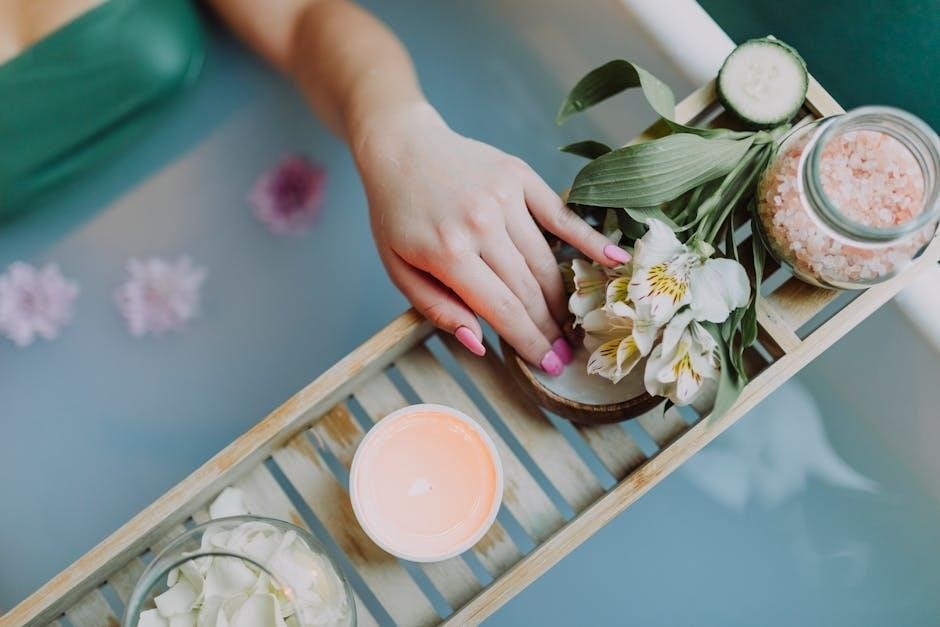
Customizing Your Massage Experience
Personalize your massage by adapting techniques to individual preferences, ensuring a tailored experience that enhances relaxation and effectiveness, making each session uniquely transformative and deeply rejuvenating.
11.1 Tailoring Techniques to Individual Needs
Adapting massage techniques to suit personal preferences and physical conditions ensures a more effective and enjoyable experience. By listening to the client’s needs, you can adjust strokes, pressure, and focus areas to address specific concerns, whether it’s relieving muscle tension, improving circulation, or promoting relaxation. This personalized approach fosters trust and enhances the therapeutic benefits of the session.
11.2 Adjusting Pressure and Pace
Pressure and pace are key elements in creating a tailored massage experience. Light, gentle strokes can soothe and relax, while firmer pressure targets deep tissue tension. Adjusting the tempo to match the recipient’s breath or physical responses enhances comfort and effectiveness. This mindful approach ensures the massage is both therapeutic and enjoyable, addressing individual needs with precision and care.
11.3 Incorporating Music and Sound
Music and sound amplify the massage experience, creating a harmonious blend of touch and tone. Calming melodies or nature sounds can deepen relaxation, while rhythmic beats may enhance energy flow. Tailoring the audio to the session’s mood ensures a multisensory experience, fostering a deeper connection between the giver and receiver, and elevating the therapeutic benefits of the massage.
Embrace the transformative power of massage with the Utopia Guide, where relaxation, connection, and well-being converge. This journey empowers you to harness the essence of therapeutic touch, fostering harmony and bliss in every session. Continue to explore, practice, and embody the principles of this guide to unlock the full potential of massage utopia.
12.1 The Journey to Massage Utopia
The journey to massage utopia is a transformative experience, blending skillful techniques with mindful intentions to create profound relaxation and connection. Through this guide, you’ve discovered the art of therapeutic touch, unlocking the potential to ease tension, nurture the body, and uplift the spirit. Embrace this path as a lifelong commitment to well-being, where every session becomes a step toward harmony and bliss.
12.2 Maintaining a Consistent Massage Practice
Maintaining a consistent massage practice is key to experiencing long-term benefits. Regular sessions help sustain relaxation, improve circulation, and foster emotional balance. By incorporating massage into your routine, you can enhance overall well-being and deepen your connection to your body. Commit to a schedule, whether weekly or biweekly, and watch how consistent practice transforms your life, bringing harmony and vitality to both body and mind.
12.3 Final Thoughts on Achieving Massage Bliss
Massage bliss is a harmonious blend of technique and intuition, fostering deep relaxation and emotional harmony. By embracing this journey, you cultivate a profound connection with your body and spirit. Remember, the true magic lies in consistency and openness. Let go, surrender, and allow massage to be your sanctuary of well-being and peace.
